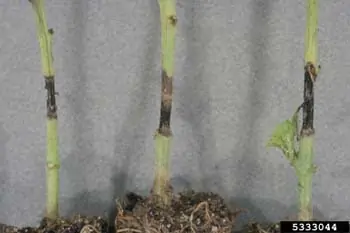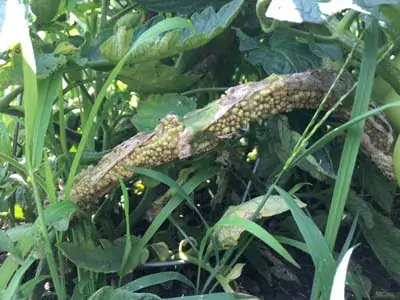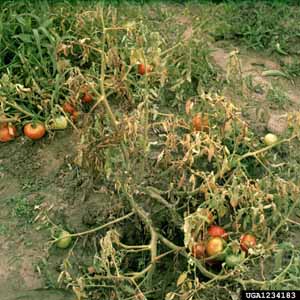Tomato stem problems can make serious loses for the home and commercial tomato growers. Some of the problems may recover through take some preventive steps, proper tomato plant care, cultural practice, and chemical applications.
But some diseases have not treatment once affected by the pathogen or other effects. Here I discuss the most common tomato stem problems and their possible treatments and solutions.
01: Southern Blight
Southern blight or southern wilt or southern stem rot is a soil-borne fungal disease caused by Sclerotium rolfsii. This is a warm-weather disease typically outbreak in summer throughout the United States.
Rainstorm after hot humid weather creates a perfect condition to outbreak the disease.
Southern blight fungus can survive in the soil around four years; moreover around 500 plant species host the disease. So, they can be a big threat to the non-commercial homeowner tomato growers.
Causes and symptoms:
Leaves turn yellow and wilt at the bottom of plants.
If you closely notice at the lower stem and upper roots of infected plants, you can find a network of fine white filaments which is the vegetative part of a fungus commonly known as hyphae or mycelium.
These can cause the plants to wilt and die rapidly due to stem rot.
Treatments and controls:
- There has no fungicide available for the non-commercial home growers. So, disease-resistant tomato varieties are recommended to avoid fungal disease.
- If you notice any sign of the disease, immediately clear out and burn the plant and the soil surrounding the infected plant. Don’t move soil from infested location to a disease’s free location.
- Crop rotation is another way to reduce the impact of the disease.
- Plant some southern blight-resistant crops such as corn and small grains to control the disease. The best solution is to skip out the diseases infested field.
- Sanitize garden tools and other equipment after using them.
- Southern blight fungus cannot survive when the temperature reaches at least 122° F. or 50° C. So, you can solarize garden soil covering with a clear plastic tarp to produce heat under it to eliminate the fungus.
- Don’t use infected leaves, garden debris, and other produce to make compost.
- Collect seeds and plants from a renowned nursery where all the precautions maintained to avoid the disease. Walking through an infected nursery or gardening store can bring the southern blight home.
- If the entire attempt fails, contact the local Extension Office for more details and other solutions of the disease.
02: Tomato Alternaria Cankers
Alternaria Cankers of tomato is a bacterial fungus causes by the pathogen Alternaria alternata f. sp. Lycopersici. It can attack the stems, leaves, and fruits of the tomato plants and cause huge damage.

Causes and symptoms:
Symptom mainly appears on the lower part of the plants. Leaves turn yellow and dark spots appear on it, soon the spots grow larger and cover the whole leaves ultimately drop off.
Dark brown lesions appear on the plant stems and soon they infected the fruits.
Small dotted brown spots appear on greenery fruits and continue into the maturing time.
Wet and humid weather condition at a temperature around 77°F or 25°C favors the disease to spread out rapidly. Heavy rainfall, dewdrops, and overhead irrigation help the spore for germination.
The pathogen can survive in plant debris more than a year and spore can travel through the air. It can also live in seed or seedlings.
Sometimes pruning may invite the disease.
Treatments and controls:
- Drip irrigation system including proper drainage system reduces the chances of Alternaria infections of tomato plants.
- Keep away from overhead irrigation.
- Avoid unnecessary pruning of tomato plants.
- Find alternaria stem cankers resistant varieties.
- Use chemical fungicide spray to control the infections.
- You can also apply natural fungicides to treat the tomato plants.
- Infected plants must be sprayed on an ongoing basis to control the infections.
03: Didymella Stem Rot
Didymella stem rot is a soil-borne fungal disease caused by Didymella lycopersici (Phoma lycopersici). It affects stems, leaves, and fruits.
This disease introduced in Great Britain earlier and later found all over the world and some parts of the United States.
Causes and Symptoms:
At first, the symptoms may appear just above the soil line with dark brown sunken lesion and finally expand to the girdle. Besides, leaves can also be affected by the pathogens if they touch the ground.
Then the canker attacks the upper part of the tomato stems. As a result, older leaves turn yellow and start wilting.
Small spots appear on leaves at the beginning and extend to the brown lesion with concentric rings and ultimately kill the tomato plants.
Many black specks often appear in the darkened stem lesions and watering over the plants or rainwater helps to spread the fungal spores to the fruits.
Fruit infection starts from the calyx end as a water-soaked lesion. Soon the lesion turned into a sunken black spot with concentric rings.
Your garden soil, infected plant debris, and tomato seeds are the main bearer of the pathogen. Besides, potato, pepper, eggplants, and other host plants also spread the disease.
The fungus can perform well when the temperature reaches 60° F.
Matured tomato plants are the main victim of the diseases. Besides a lack of nutrient supply like nitrogen and phosphorus can also encourage the disease.
Treatments and controls:
- Use disease-resistant tomato varieties.
- Use disease-free healthy seed from the reputed seed company.
- Remove the infected plant debris after the end of the season and destroy them.
- Avoid planting tomatoes and other host plants (potato, pepper, and eggplant) in the same field at least for three years to reduce the risk of the diseases.
- Always water in the soil around the tomato plants and avoid overhead watering. You can also apply drip irrigation to reduce the risk.
- Ensure no tomato plants become injured during work.
- For greenhouse maintain the temperature above 60° F and the humidity below 90%.
- Prune the lower and older leaves of the tomato plants.
- Wash your hand properly and sanitize your garden tools every time you work in the field.
- Ensure proper spacing between plants around 2-5 feet (based on varieties) for the greenhouse as well as outdoor plants for enough ventilation.
- Apply fungicide spray on time to control the disease.
- Use tomato staking or caging to reduce the incidence of the diseases.
04: Tomato Stem Primordia
Tomato stems primordia or bumps on tomato stem is a very common tomato plant problem. It mainly causes for environmental effects. Besides some tomato caring mistakes and root problems may also cause the problem.

Causes and Symptoms:
Some white spikes may appear on tomato plant stem after heavy rainfall.
Besides, overhead watering, internal injury, high humidity, the poor drainage system, and herbicide effects can also occur bumps on a tomato stem.
Moreover, this unusual bump may appear when the plants fail to contact with their root system due to some hormonal blockage. As a result, white growth develops on tomato plant stems.
However, these bumps are also a symbol of tomato root diseases.
There has nothing to worry about the bumps unless your tomato plants showing any stress of wilting or yellowing.
Any part of the tomato plant stem which touches the ground can develop a root system.
Therefore, the tiny hair of the stem turning into bumps due to the above reasons. That’s why planting tomatoes deeper can create a strong root system.
Treatments and controls:
- Be patient and don’t worry. This will not harm your plants.
- Observe the tomato plants closely to find any sign of wilting or yellowing for a few days after the bumps appeared.
- Plant tomatoes deeper as much as you can when transplanting tomatoes.
- Make proper soil amendments before transplant tomato plants.
- Ensure proper drainage system.
- Check the soil humidity before watering tomato plants.
- Proper spacing between plants can provide enough air circulation and reduce the risk of primordia.
05: Tomato Timber Rot
Timber rot is a devastating stem rot disease of tomatoes caused by the fungus Sclerotinia sclerotiorum. This is very similar to white mold which has a host range of over 300 crops and vegetables.
Greenhouses and high tunnels are mostly susceptible to timber rot diseases.
Causes and symptoms:
Timber rot may appear on tomatoes during the flowering time due to over foliage and poor aeration.
Also, the cool and wet weather conditions when temperature prolongs between 59˚ to 70˚F under high humidity level favors the diseases to spread out easily.
Besides, continuous heavy rainfall, overhead watering, and sprinkler watering also outbreak the disease.
Symptoms may appear near the main stem base or from the stem axils which develop water-soaked spots.
If your tomato plants being injured during working in the field or anyway, this fungus may attack in the injured area and affect the internal plant tissues. After that, the fungal infections spread outward and fuzzy mycelium appear on the plant stem.
Usually, the pathogen of the timber rot fungus Sclerotinia sclerotiorum can be transmitted in four different ways. Such as:
- Host plants and weeds from the adjacent infested filed.
- When the wind flows over the disease-infested field and through the garden tools.
- Surface irrigation water and rainwater is another way to transmit the diseases.
- Harvested tomato seeds from the disease-infested field.
Treatments and controls:
- Sclerotinia sclerotiorum can survive in the soil up to 10 years so some preventive steps should be taken to reduce the risk of the diseases.
- Use diseases free seeds from reputed seed companies.
- Find some diseases resistant varieties if available.
- Sanitize your garden tools properly after fieldwork.
- Make proper soil amendments to ensure good drainage system. Check soil moisture each time before watering your tomatoes.
- Plant tomatoes with proper spacing for good aeration.
- Sometimes mild pruning helps to reduce the leaves’ density and develops wind exposure.
- Besides, use staking and caging to reduce the high humidity and protect your tomato plants from timber rot and other tomato plant diseases.
- Remove the infected tomato plants promptly along with the soil in an 8-inch circle and 6-inch depth for each plant once you notice any sign of sclerotinia stem rot. This will help you to protect the unaffected tomato plants.
- You should also bury the infected plants very deep in the ground where no host plants are growing.
- After removing the affected plants use plastic mulch barriers for healthy plants can stop spreading the diseases originating from the soil.
- Ensure your nearest fields are not infected by the disease.
The fungus Sclerotinia sclerotiorum has a wide range of host plants, vegetables, and weeds such as snap bean, lettuce, pumpkins, carrots, cucumbers, peas, potato, tomato, alfalfa, soybean, sunflower, canola, pigweed, Canada thistle, lambsquarters, wild mustard, and other host plants.
Other Tomato Stem Diseases
There have some other tomato stem problems which also affect tomato leaves and fruits such as:
- Bacterial Speck on Tomato Stem (See tomato fruit problems)
- Bacterial Spot on Tomato Stem (See tomato fruit problems)
- Bacterial Canker on Tomato Stem (See tomato fruit problems)
- Early Blight on Tomato Stem (See tomato fruit problems)
- Late Blight on Tomato Stem (See tomato fruit problems)
- Fusarium wilt on Tomato Stem (See tomato leaf problems)
If you want to learn more about the following stem problems also see reference pages.
Read More:
*** 7 Basic Reasons Behind Common Tomato Plant Problems
Sources and Citations:
- https://content.ces.ncsu.edu/southern-blight-of-vegetable-crops
- https://www.seminis-us.com/resources/disease-guides/tomatoes/didymella-stem-rot/
- https://www.veggiegardener.com/tomato-quirks-bumpy-stems/
- https://www.gardeningknowhow.com/edible/vegetables/tomato/white-growths-on-tomato-plants.htm
- https://www.gardeningknowhow.com/edible/vegetables/tomato/treating-tomato-timber-rot.htm
- https://extension.psu.edu/frequently-asked-questions-about-timber-rot-on-tomato



